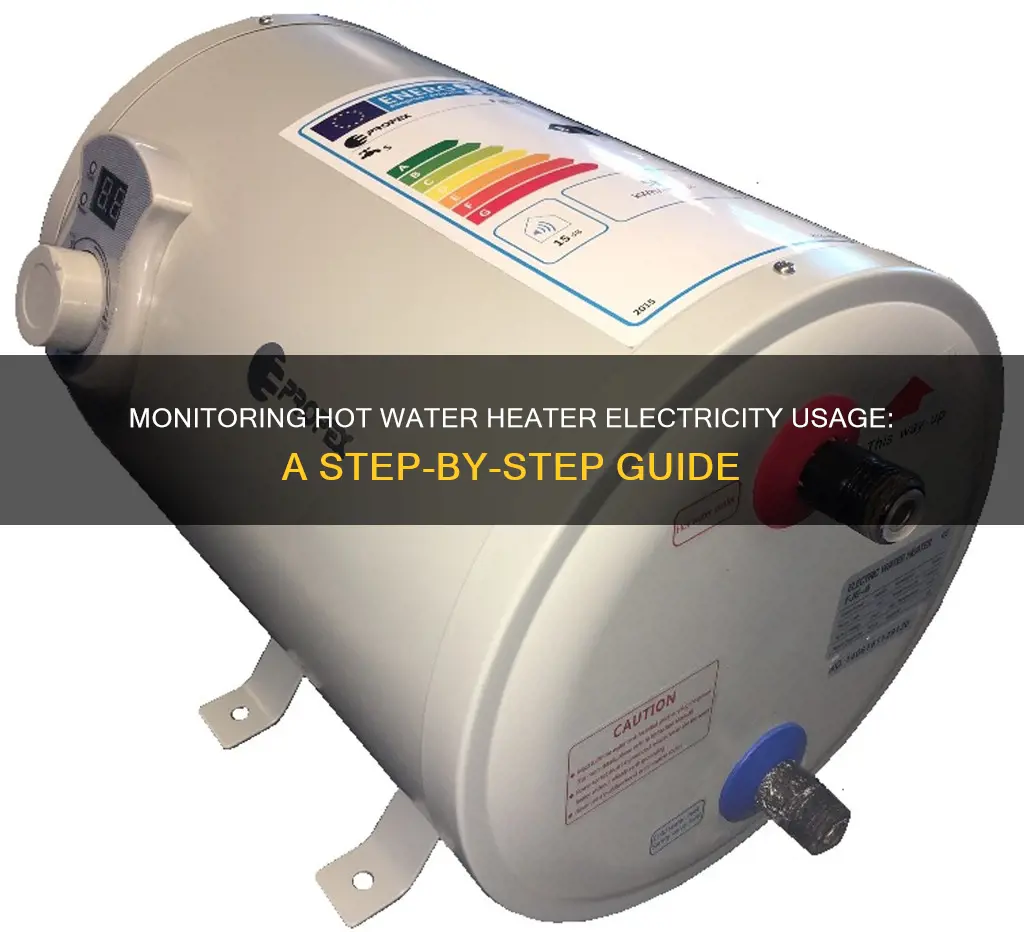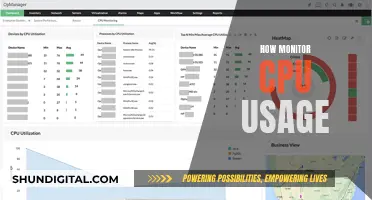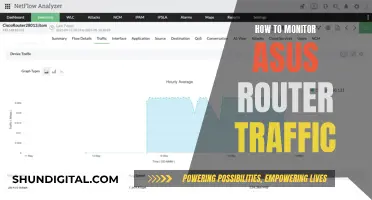
Monitoring your electricity usage is a great way to keep your energy costs down and reduce your environmental impact. Water heaters are often the second-biggest energy user in most homes, and the biggest user for those who don't use much heating. There are a few ways to monitor your electricity usage, from buying metering equipment to using a standard power meter or a data-logging meter. You can also calculate your usage by measuring your hot water use over a week and then using the formula Q = MCp (T2 - T1) to work out the total energy used.
| Characteristics | Values |
|---|---|
| Average daily hot water usage | 45 gallons |
| Average daily electricity usage | 4000 watts |
| Average daily running time | 3 hours |
| Average annual cost | $550 |
| Methods to reduce electricity usage | Install a timer, use low-flow shower heads, use cold water for laundry, turn off water when brushing teeth or shaving, take quick showers, insulate the tank, install a dedicated sub-meter |
| Devices to monitor electricity usage | Power meter, TED, IoTaWatt, Eyedro, Sense, eGauge, Brultech, standard electricity meter |
What You'll Learn

Install a dedicated sub-meter
If you want to monitor the electricity usage of your hot water heater, one way to do it is by installing a dedicated sub-meter. This method will give you the direct total energy use of your hot water heater.
To install a dedicated sub-meter, you will need to purchase metering equipment. This equipment can be expensive, but it will provide you with accurate data on your hot water heater's electricity consumption. The metering equipment typically consists of a box and a meter, which will need to be installed near your hot water heater.
The process of installing the sub-meter may vary depending on the type of equipment you purchase and the configuration of your plumbing system. It is recommended to consult a professional or a detailed guide specific to your equipment to ensure proper installation.
Once the sub-meter is installed, you can monitor your hot water heater's electricity usage over time. This data will help you understand your energy consumption patterns and identify areas where you can optimize your usage to reduce costs and environmental impact.
It is worth noting that there are alternative methods to monitor electricity usage if installing a dedicated sub-meter is not feasible. These methods may involve measuring hot water usage and calculating the associated energy costs, or using devices like power meters that can be purchased online. However, these alternatives may not provide as accurate or comprehensive data as a dedicated sub-meter.
Uncover Hidden Internet Monitors: A Comprehensive Guide
You may want to see also

Measure hot water use over a week
Measuring hot water usage over a week is a great way to understand your household's water heating needs and identify areas where you can save energy and money. Here's a step-by-step guide to help you through the process:
Step 1: List All Hot Water-Using Appliances and Fixtures
Start by making a comprehensive list of every device and fixture in your home that uses hot water. This includes showers, bathtubs, sinks, dishwashers, washing machines, and any other appliances that require hot water.
Step 2: Estimate Usage Per Fixture
Now, you need to estimate how much hot water each fixture or appliance uses. Here are some averages to give you an idea:
- The average shower uses about 2 gallons of water per minute. For a 10-minute shower, that's 20 gallons of water.
- Bathroom and kitchen sinks typically use 1-2 gallons of water per minute. Running the hot water for 10 minutes would consume 10-20 gallons.
- ENERGY STAR-certified dishwashers use 3-5 gallons of hot water per cycle, while some powerful cycles may use up to 9 gallons.
- A standard washing machine uses about 20 gallons of water per load.
Step 3: Calculate Peak Usage Times
Consider the times of day when multiple hot water fixtures or appliances are in use simultaneously. For example, morning and evening times are usually peak hours for hot water usage. Ensure your water heater can handle these peak demands.
Step 4: Measure Shower Times and Flow Rate
Focus on your shower usage for a week. Measure the duration of showers and calculate the average. Then, determine the flow rate (gallons or litres) of your showerheads. You can do this by collecting water from your showerhead in a bucket for a set amount of time and measuring the volume.
Step 5: Calculate Total Hot Water Usage
Multiply the average shower time by the flow rate to find out how much hot water is used per shower. Do this for all other hot water activities as well, and then add them together to get your total hot water usage for the week.
Step 6: Determine Energy and Cost
Now that you know your total hot water usage, you can calculate the energy required to heat that amount of water. Use the formula Q = MCp (T2 - T1), where Q is energy, M is mass, Cp is specific heat capacity (4.18 kJ/kg K is a good estimate), and T2 and T1 are the final and initial temperatures, respectively. This will give you the total energy in kJ. To find the cost, divide the energy in kJ by 1,000 and multiply by your cost per kWh.
Step 7: Consider Efficiency
Remember that your water heater is not 100% efficient. Account for heat loss by including an efficiency figure in your calculations. The exact figure will depend on the insulation and age of your water heater.
By following these steps, you'll gain valuable insights into your hot water usage patterns and can make informed decisions about water heater sizing, timing, and potential energy-saving measures.
Monitoring CPU Usage: A Comprehensive Guide to Tracking Performance
You may want to see also

Use a standard power meter
If you want to monitor the electricity usage of your hot water heater, one option is to use a standard power meter. This method was suggested in a forum post from 2018, where the user was looking for a reasonably priced option to monitor a single 240v circuit.
Using a standard power meter has its pros and cons. While it will give you an accurate reading of your hot water heater's electricity consumption, the setup can be bulky and may not provide detailed information about when the power is being used.
- Purchase a suitable power meter: You can find power meters online or at hardware stores. Some recommended models include the P3 Kill A Watt EZ, bayite power meter, and the Aeotec Heavy Duty Z-Wave switch. Compare features and prices to find one that suits your needs and budget.
- Installation: Consult an electrician to ensure safe and proper installation of the power meter. You may also find online resources and forums with installation advice and instructions.
- Data Collection: Once installed, the power meter will measure and display the electricity usage of your hot water heater. Note that basic power meters may only provide a running total of kilowatt-hours (kWh) consumed, without breaking down usage by time of day or specific time intervals.
- Calculating Costs: To calculate the cost of running your hot water heater, you'll need to know the price you pay per kWh from your electricity provider. Multiply the kWh reading from the power meter by the cost per kWh to get the total cost.
- Comparing Usage: To track changes in electricity usage over time, record the power meter readings at regular intervals (e.g., daily, weekly, or monthly). This will allow you to see the impact of any energy-saving measures you implement.
- Consider Additional Options: While a standard power meter will give you overall electricity usage, you may also want to explore other tools that can provide more detailed data. For example, smart plugs and energy monitoring systems can give you insights into usage patterns and identify "vampire energy" drawn by devices in standby mode.
Remember, monitoring your hot water heater's electricity usage is a great first step towards understanding your energy consumption and identifying areas where you can save money and reduce your environmental impact.
Monitoring CPU Usage: Optimizing WordPress Performance
You may want to see also

Monitor with a data-logging meter
If you want to monitor the electricity usage of your hot water heater, you can use a data-logging meter. This device will help you track how much electricity your heater is consuming and can provide valuable insights into your energy usage.
There are a variety of data-logging meters available on the market, and they can be purchased online or from electrical stores. Some popular options include the TED 5000 Home Energy Monitor, Extech DL150 TRMS AC Voltage/Current Datalogger, and the EyeHydro, which offers two clamps for monitoring and can be expanded with additional sensors.
When choosing a data-logging meter, consider your budget and the features that are important to you. Some meters offer cloud-based services, while others provide local monitoring and storage. You may also want to look for a meter that can be integrated with your home automation system if you have one.
Once you've purchased your data-logging meter, you'll need to install it properly. This may involve enlisting the help of a licensed electrician, especially if you're monitoring your entire home's electricity usage. For safety, it is always best to consult a professional when dealing with electrical installations.
After installation, your data-logging meter will start tracking your hot water heater's electricity usage. Be sure to check the data regularly to gain insights into your energy consumption patterns. This information can help you make informed decisions about your hot water heater usage and identify any areas where you can improve energy efficiency.
By monitoring your hot water heater's electricity usage with a data-logging meter, you can take control of your energy consumption and potentially reduce your environmental impact and lower your utility bills.
How Do Apartments Monitor Water Usage by Each Unit?
You may want to see also

Use a timer to turn the heater off at certain times
Water heater timers are a great way to monitor and control the electricity usage of your hot water heater. These timers are programmable devices that allow you to turn your water heater on and off, ensuring that you only heat water when you need it. This is especially useful if you have a set schedule or are away from home for long periods.
Water heater timers can help you save money and reduce your energy usage in two key ways. Firstly, they prevent standby loss by keeping the tank off during periods of non-use. Secondly, if you have a variable rate with your power utility, a timer can ensure that your water heater isn't using energy during "peak" price periods.
When choosing a water heater timer, you'll come across two main types: analog and digital. Analog timers are similar to traditional mechanical timers, with a manual schedule-setting clock face. On the other hand, digital timers are controlled by electronic signals and can often be controlled remotely via Wi-Fi or smartphone apps, offering more convenience and flexibility.
When creating a schedule on your water heater timer, consider the times of day when you typically use hot water. For example, if everyone is out of the house during the day, you can set the timer to turn off the heater during those hours. Additionally, keep in mind that a typical tank needs about 30-60 minutes to fully heat up, so factor that into your timer schedule.
Installing a water heater timer is a straightforward process for those with some DIY experience. It involves rerouting the power cable of your water heater through the timer and then connecting a new cable from the timer to the water heater.
By using a water heater timer and setting a schedule that aligns with your hot water usage, you can significantly reduce your energy consumption and save money on your utility bills.
Water Usage Monitoring: A Standard Practice in Hotels?
You may want to see also
Frequently asked questions
You can monitor your electricity usage by purchasing and installing metering equipment. This will give you a direct total energy use.
If you cannot afford metering equipment, you can measure your hot water usage over a week by measuring shower times and taking a suitable average. Then, with the flow rate, calculate how much hot water was used. Measure all activities that use hot water and multiply this by how many times per week you use hot water.
You can also use a standard power meter, or a power meter that can be purchased on eBay or Amazon.
A typical water heater uses around 4000 watts and runs for about 3 hours a day. Newer, more efficient models may run for only half the time during each day.
To lower electricity usage, you can invest in low-flow shower heads and faucets, use cold water for washing laundry, turn off water when brushing your teeth or shaving, take quick showers and fewer baths. You can also invest in a more modern and efficient water heater, especially if you are using an older model.







